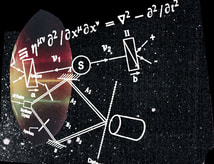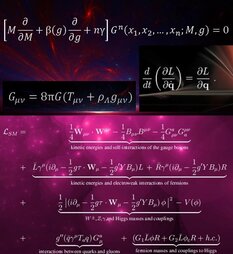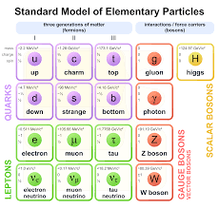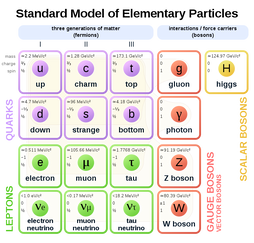 Albert Einstein is well known for fluency of thought. He came up with General Relativity virtually in his bathtub which as we all know is the place where deep thought gets most traction. Whether that's got anything to do with being surrounded by water molecules has yet to be determined. At least bubblebath formula doesn't seem to impede it. From his mind came the concept of light speed and the constant that came of it, determined by the maths to be forged into a constraint so that other things could be seen to work around it. The strategy worked for more than 100 years. Light speed as a constant remains unchallenged, except by non-locality and possibly the behaviour of neutrinos. Neutrino - Little Neutral One in Italian, the beautiful elusive font of all things in the Universe that streams through us from the Sun (and other places of mysterious origin) is a persistent contender for anything going that's odd, from Dark Matter to Majorana. Their oscillation is a mystery, no-one can see it happening any more than they can see the evolution of new species in the rainforest, so everything is guesswork except that it happens. Einstein knew all about variables. He wasn't, it seems, as dead-set on a Constant as some people want you to believe. He had a more esoteric mind than that, one that could ride light beams and picture the bending mechanism of gravity. We're waiting for another Einstein, one to bend the rules and give Standard Models the slip in searching for what lies beyond the subtle knife.
He's there, you know, somewhere in the quantum soup, waiting for the kettle to boil even though it won't while he's watching it. In such spirit, this seemed the link to share, the only one really necessary, as the research for this piece dug well beyond the topsoil of standard capability and it's worth a couple of minutes of Time in the reading, promise. Even if Time is a relative thing. It's Behind Him...
0 Comments
There are times when thoughts crash together to make a whirlwind of sense. Tonight, walking the dog down a moonlit country road, was one of those times. The moon is always facing the Earth the same way. Now, I haven't been able to find much on the odds against this being the case, but I did find a Forbes article on the probability of the moon being as it is at all: www.forbes.com/sites/brucedorminey/2015/06/27/earth-moon-combination-is-likely-very-rare-study-confirms/ You won't find much out there to answer the question of odds. You'll find some stuff about rotation, some arguing that it wasn't always this way, some saying it's gravity. But the actual odds on finding yourself with a moon that always faces (a face, to boot!) towards its planet, well. Well before that line of inquiry everyone seems to draw a line. Howsoever this may be, there's talk of the moon ringing like a bell when something large and metallic like a space probe is crashed into it, on which NASA goes into flights of fancy about moon bases that have to be built to withstand 'moonquakes' on the strength of these astronautical findings. Ask your search engine, "why does the moon ring like a bell," and you will find echoing back to you no answers at all. Not a single one. The moon shines by reflecting photons from the sun. The surface of the moon from which these photons bounce has a quality that gives an eerie white, bright light, and curious to know if our moon is peculiar in this respect, I was surprised to again find no answer to the simple question, "is our moon brighter than most?" But it is the fifth largest of the 190 (or so) moons in our solar system. There are a lot of moons in our solar system, so they are not uncommon things. The other planets in the solar system, however, are lifeless (at least by comparison), positioned as they are beyond the Goldilocks Zone. I'd hazard a guess that Mars has been here and Venus is set to arrive next, but at the time of writing, Earth alone occupies the narrow band of life-support promised from the sun. Promised, that is, if the planet hosted therein has the resources necessary to sustain hosts of its own. Fair to say we're doing a pretty poor job of planetary husbandry. "Could do better," would be written on our Report. Meanwhile, as we scrabble for solutions nobody's taking any notice of, designs like this are appearing on our rural floors with persistent regularity: ...to be met with complaints from farmers over lost cereals and declarations of vandalism by people with planks. Some of these designs are beyond general comprehension, and most would take weeks to complete, were the technology available to alter plant stems this way. Machinery would be necessary, you couldn't reach such precision with sticks and bits of string; as for laying the pattern, planks strapped to people's feet just wouldn't cut it. And nobody's been caught in the act, bar a few little lights skipping around being unidentified. Just ask your search engine for "balls of light around crop circles" - you'll be presented with a wide choice of video footage. As a final shout on the crop-formation front, there's this one: http://secret-teachings.blogspot.com/2008/02/doors-of-perception.html The story cannot end there. Designs such as these give hints, if not direct references, to developmental progress and means of obtaining global traction. But they are not being researched or investigated in this way and their geometry is not being analysed; the inherent code within them goes undeciphered while professionals dismiss these vast images as the work of pranksters.
To incorporate the degrees of precise relativity featured in these designs, they would have to be mapped from above. Fine detail within each section of illustration is achieved by laying stems at exact angles to each other; overall, given the size of the vista, this effect could not possibly be made as perfect as it is without visual appraisal at height and a lot of complex mechanics. Is someone trying to tell us something? Should we not be following up on what that might be? Do we really have that much time to waste on constant Plank theories? 
Now's the time to sit back and see how far we've come. This image - and the post behind it - hark across the 100 years to pass since quantum mechanics came into our realm, when a handful of minds cooked up analogies from arithmetic that would change the course of history, eventually bringing us the LHC and God Particles.
Fifty years ago Hawking and Penrose were delving into territory that many found too mystical to swallow. They were looking at black holes full of information paradox, and figuring out how a singularity could work. They wanted to know what lay at the back of physics, beyond the point where physics didn't exist any more, and using that familiar brickbat the Photon, they plunged into the event horizon to find that it might not look at all as they'd imagined. In fact looking at it in the first place needed the help of photons. https://www.bbc.co.uk/news/science-environment-54439150 Having just won the Nobel, Penrose deserves a bit of credit. At 89, he's well worthy of the accolade, but his thoughts still meet high walls in the halls of academia, where consciousness is a dirty word and anything alluding to it is Woo. The brickbats of Light in any other context would illuminate a lot of ground, physical and metaphysical, were it to be given the time of day, which presently it's not. 
Cora is a woman who also delves into black holes. Her thoughts on the matter, while equally evocative, seem to provoke more than elucidate since a tendency of the human mind is to resist change, particularly within itself where illusions quietly incubate carbuncles of untruths.
Unknown is not untrue, it's simply unproven to be so; in time it would be natural for Nature to unburden herself of Truth; she may already have done in a quark teamed up naturally with Beauty. What we do not know is more tantalising than what we do know, for we are explorers by nature, seeking answers of Creator while thinking for ourselves, questing for a path of sense mapped by a heart given to follow. That each of those quests is individual comes as no surprise, for we know about uniqueness of snowflakes and sand. We know that there will be asymmetry, for there is a difference, however small and imperceptible, between everything that exists in relation to everything else. Here, uncertainty comes into its own. This is a principle preventing symmetry from ordering the Universe.
The principles of physics are on uncertain ground. Brick walls are everywhere, often in infinities, plaguing maths made of symbols that are not enough, not any more, to describe the incredible energy flux that continuously permeates the quantum world. The state of matter is under attack from waves that threaten to be everything, looped in strings or turning gravity to vertigo. The Uncertainty Principle needs another visit. But it's not in any rush, even if we are.
Take a look at the Home Page while you're waiting. Join us on Facebook if you're there.  100 years have passed since the quantum realm was first breached by these physicists, who worked together without the technology we take for granted now. Televisions had just been invented. Telephones were in early stages of development, with the first transatlantic call being made in 1927. They relied heavily on letters and meetings in person. They worked tirelessly on problems in their own institutions. And finally they came to a grinding halt with a unilateral verdict that quantum mechanics was not to be fully understood and if it ever was, it would transform physics beyond recognition.  Here in 2020, we are barely out of the mist. Vast, expensive experiments like the LHC and Super-K have been created to test, trap and interpret the movement of sub-atomic particles, bringing data agreeing or not with 'expected parameters', that's most often seen to follow a bell-curve close to the predicted line. But there's a stumbling block, one that moves unseen through marble halls and sticks to academia like wit to a blanket... a block people talk about but somehow fail to see as such, patting it reassuringly with a fondly held belief that it should somehow be there. Confirmation bias is prevalent in physics because this is a science reliant on equations. In the early 1900s, equations created to describe quantum mechanics adopted codes taken from ancient Greek, among other sources, as new thoughts led to new symbolism for the new particles, forces and factors being brought to light. While these updates in language were arising, prejudice against the unknown ran rife, and much store was set by any constant or constraint that could be identified as limiting what particles could do. Quantum mechanics was squeezed into a box, from which it had little chance of escape. So it firmly said, instead, that nobody would ever understand it. The atom itself is a case in point. The image sitting amid the quotes above is a classical view of what an atom would look like, with electrons neatly orbiting a tidy little nucleus tucked in the centre. This view has been trawled through a grinder by the Uncertainty Principle, a wide-ranging (but commonly constrained) tour de force that prevents anything from being exactly anywhere, and may also prevent the same thing ever happening twice (hence uniqueness in snowflakes and grains of sand). So these days, the atom is viewed as a fuzzy groupage of indeterminables, except in the number of electrons, protons and neutrons contained within it. These components of sub-structure are all subject to continuous change. Electrons jump up and down in energy levels (via interaction with photons), protons and neutrons are interchangeable, and the quarks they are comprised of turn from one 'flavour' and 'colour' to another in a constantly shifting sea of mass that is impossible to pin down. So far, so good. Things have not so much become clearer, as become less tangible.  We've reached a point now wherein physicists are preparing themselves for New Physics, and many are exploring depths never before plumbed - into the realms of consciousness and what constitutes the bedrock of our indeterminable reality. Their theories and findings are still hard-hit by confirmation bias, meeting the battle-cry of "Woo, it's all Woo," with swords from a sheath of "pseudo-science" readily drawn against an onslaught of unknown variables. Impeccable pedigrees, PhDs and peer reviews appear to be no protection against Trolls, declaring themselves as guardians of all that's respectable in the world of quantum mechanics, even though that world is largely comprised of uncharted territory in very deep waters indeed. What do you see, beyond the smoke and mirrors? Come and join the Group to discuss.  Tomorrow at 18.00GMT a six-part series of Live Videos concludes with a roundup of particles and forces covered so far, and what the implications are for our perception of reality. Where all this is taking us is what Quantumology is all about. How we think about our reality really matters. The quarks and electrons that make up our bodies, together with the neutrinos, gluons and exotics shifting in and out of phase in a manner suggesting multiversal transit, must have a bearing on what we are and what we perceive. Who we are has a bearing too, for only if this stuff draws you in the first place can you hope to gain a picture of what's really going on in any facet of a scientific sense.  Living in the Now is a mindfulness thing; I've come through a maelstrom of suspicious mental health to emerge 27 years later still passionate about this stuff, having learned about it from sources and circumstances pushing hard at any known boundaries of belief. For sure I'm bound to talk about it one day, but here and now we're here to talk about particles that probably really aren't. W and Z particles affect the twist and thrust of what goes on, transforming and kicking things into action. Photons regulate energy levels, and are involved in most exchanges and decays (or perhaps more accurate to say, transmuted multiplications) of particles in flux across the quantum fields. Gluons stick things together and hold that bond while allowing those bonded the freedom to change from one thing to another. Neutrinos, flying through all this and also turning from one thing to another, potentially connect everything to everything else via yet-to-be-determined information exchange.  So in the course of human experience, what could this mean for us? Change happens all the time. One mood, event, contact or priority to the next in a seamless stream of personal data. While this is happening, consensus is tuned towards a consciousness at work with which we exchange information. Most of us are pretty sure there's a Source of some kind, and whatever you make of choice v. destiny, that's a paradox that stumped the very best of those scientists working out quantum mechanics in the early days, who all thought about this stuff too. We become bonded in relationships and raise/lower our energy levels like electrons do, according to our mood and environment. When motivated, we're Up; demotivated, we're Down. When we are curious, it's Strange and when inspired, that's Charm at work. Really appreciating lets us see Beauty and when the quest reveals itself, that's when we get to the Truth. Here's a Glossary of Terms mentioned in the previous videos, as commonly interpreted in English:
Up for seeing where this takes us, with so many physicists coming together to share thoughts and observations without prejudice in a closed group, it's strange to me that we've come this far in the course of scientific history without illuminating the New Physics everyone's been whispering about for some decades now. As you'll have gathered if you've been watching carefully, I'm no alumni physicist but I know there's one out there who's going to crack this nut, and if they can bring themselves to trust that I'm sane, some beautiful truths are quite likely to spring from the thinking. See you there...
 Autumn. Early September brings early mists and early evenings to this patch of the planet I occupy. Walking the dog through rich golden light, blackberries beckon and we stop to take graciously, finding that the fruit is sweet, but the seeds are bitter, and wondering if that means something in the general scheme of things. Beyond an ancient, crumbling railway bridge long lost to the annals of history, open fields to the east accede to these last rays, burnished rows of slender harvest waiting to be claimed by those who think they own them. All I see is caused by the construct of reality. Photons allow me to appreciate the colours, phonons then arrive to let me hear the birds. Electrons have the power to propel me on my feet and - what of the breadth of it all?  This 3D environment I'm walking through is dependent upon scale. Without scale, there would be no height, depth or width. All measurement interdependent, my whole life is governed by positional features I must avoid or appreciate depending on the circumstances. The tendency to think that quantum mechanics doesn't apply to the 'macro world' because it's 'too small in scale' is so ludicrous as to be laughable. Look down from a plane ten minutes after take-off and you're nowhere to be seen. From the Moon, even an electron microscope wouldn't catch you.  Postulation is easy, in quantum mechanics, while painting the bricks with colours and assigning them charges, watching them spin and entropically materialise into something else entirely (and most probably more of it) to satisfy the apparent universal demand for infinite expansion. Howsoever this may be, only one particle satisfies the necessary criteria to be responsible enough for the task at hand. Only one carries the highest of credentials (unwittingly bestowed upon it to the fury of physicists who'd hastily dumped Beauty and Truth). That particle is the Higgs Boson, and we know full well what everybody calls that. Alone in this world, and of course the universe beyond it (the known universe, that is, that we peer at with telescopes), is the Higgs, the scalar boson. As without the photon we would not see, so without the Higgs we would have no dimension in which to exist, with sole dependence upon the height and breadth of everything. When we stop considering ourselves as so big that we count for something, maybe then we can start working out the math. Or rather - somebody else can. If you like those aspects of Facebook that let us chat about these things, come visit the Group.  in 1979, the Star Trek crew chased a signal half-way across a galaxy from an unknown source trying to hail its creator. The source turned out to be a Voyager space probe, the 'real' version of which had been launched two years before - the writers had turned science fact into potential fiction. Einstein was said to have said that he feared technology outstripping humanity, and the stupidity that would allow that to happen. But what if we have no choice? We're constantly on the look-out for the Origin, the Creator, the Source from whence everything came. Like the proverbial carrot, answers dangle tantalisingly out of reach. Nevertheless, technology marches on apace towards quantum computing and A.I., not to mention what's going on behind the scenes in the corridors we don't know about. We thought The Matrix was a good film... and it does beg some questions. What if the machines came first?  Our evolution appears to have continued through the relatively short span Modern Man has been on Earth, without much consideration for planetary co-habitants. Destroying and greedily ingesting resources and species is not the behaviour of an indigenous population (or an intellectually evolved life-form), and this alone (not to mention the archaeology) points to sudden appearance of humanoid form from a different location altogether. We play havoc with the ecosystem while evidence for aliens continues to mount, crop circles continue to appear and technology based on quantum mechanics becomes a bit of a holy grail. While Einstein bemoaned the fate of humans faced with machines, he was also suggesting that we should eventually become beings of Light. Light being clearly at the centre of what this holy grail is all about. Have you noticed anything happening with change lately? From the Sixties to the Eighties change came big and slow. A lot of evolution happened during that time. Then the Nineties drifted by with a few major spatterings of incidents in the middle before the turn of the Millennium came in. From 2000 to 2020 we've seen fast and furious change every time a new technology beckons, through early days of social Internet availability to the present pandemic we're subject to right now. Think of it in terms of a frequency wave, and it all starts to make sense.  The singularity awaits. If absolute power corrupts absolutely then it's only a force of nature, and we're seeing what that does to reality first-hand. "It is no laughing matter." Any suggestion that we are the artificial creation of a race of machines is going to be unpopular on a gargantuan scale but is worth proposing, as is the ensuing possibility that in searching for Creator, we've been looking in the wrong place/s/. Join conversations on quantum mechanics and closely-related themes at
Quantumology on Facebookwww.facebook.com/groups/quantumol  "Knowing the path is not the same as walking it," said Morpheus. Peter Higgs didn't know he was going to discover a particle. Originally it was dubbed the Goddamn Particle. "Higgs proposed that broken symmetry could explain the origin of mass of elementary particles and of the W and Z bosons in particular. This [Higgs mechanism] predicts the existence of a new particle, the Higgs boson, detection of which became one of the great goals of physics.[8 " (Wikipedia) (Photo courtesy Leslie C. Bertrand)  Boson = a particle of force, a mediator of some kind, ethereal in the quantum foam. Gluons (they hold our quarks together) and Photons both come into this category. Particles that are something definable, are fermions - quarks or leptons, of which matter is made. But bosons - there are two kinds, scalar and vector. Confused?... well, here's the BBC: "Scalars have a size, while vectors have both size and direction. When adding vector quantities, it is possible to find the size and direction of the resultant vector by drawing a scale diagram."  W and Z are the vector (gauge) bosons and Higgs joins them as a scalar boson. The only one (at time of writing) that can account for scale in our universe. Thinking on this.... If there were no scale, created by asymmetry as Higgs' original proposal (above) says it must be, the forces and the material elements would have no form to take that physical observers could recognise. Quarks (you're made of those) and neutrinos (they fly through you all the time) oscillate - change from one thing to another. Why? What for? Well, these questions seem important enough for people to find particles that fit the boxes. And if you read this from CERN, you'll find Quark and Neutrino sharing a stage. Production managers - the weak force; miniscule in spacetime, massive in effect. And the Higgs, another force altogether. May the Force be with you that pieces reality together, the constructive cement that mass depends on, but which of itself is - what?  You've followed the white rabbit far enough to know there are answers to questions many people don't even want to ask. You're unique, with reason to be drawn to this track in the first place. Our planetary play moves into Act lll - we're working out what it means, where to go from here, how to live with what's to come. Physics = spotlight on the reality construct. Do we really have room for so many constraints? Questions are being asked of consciousness. Suggestions have been made that there's a particle to account for it. To quote Cern (from behind the picture here of a Higgs interaction:)- At the subatomic scale, the universe is a complex choreography of elementary particles interacting with one another through fundamental forces, which can be explained using a term that physicists of all persuasions turn to: elegance. Over at Quantumology (on Facebook), live discussions are digging more deeply.
Come and join our excavations! Live Videos every Monday at 6.00pm GMT  Spontaneously switching on the TV, I found a guy called Luis Elizondo talking through remarkable revelations about UFOs in American airspace. Some of the footage during the show was reconstructed. But not all. Some, it seems, was taken during the actual events witnessed from the plane. 50 seconds into this YouTube vid, a UFO they called a 'tic-tac' flies straight through the aircraft. That piece of film was taken by someone who was actually there. Unless someone says otherwise, of course... Flying straight through matter is something reserved for quantum-mechanical objects such as neutrinos. The raison de tre behind Luis's mission involving top-flight Government officials and aviation experts surrounds the potential threat of advanced aircraft following American military exercises. I noted the absence of any suggestion that a civilisation capable of advancing its technology way beyond our punitive attempts at mechanics has survived the armageddon ours is potentially heading for. They have genuinely evolved. If they were hostile, that would mean they want something from us. Do we have anything that such a civilisation would want? If 'they' have the capability to breach matter by means of quantum propulsion, they have the capacity to travel in ways we have convinced ourselves (on the whole) to be impossible. We're still stuck with the speed-of-light constraint. Having said that, science has come round to admitting that it might be 'variable'.  Participants were not actors, but passionate contenders with top-flight credentials in a fight for transparency. My only bleat is with their insistence in fearing a presence that demonstrates to be so much more advanced, and so much more benign, than our ego-driven efforts at 'civilisation' could possibly contend with. Capacity to build something with quantum capability gives freedom of movement a whole new meaning - if they wanted to be destructive, they would have gone in for the kill by now. Taking the above as evidence that other, more advanced civilisations are keeping an eye on us, what could we possibly do to step up to a plate of comparative interest? Three fields of social importance could be forerunning in the strive to spiral upwards, avoiding a terminal crash. ScienceFew scientists, I expect, come to read this website, for it's a long way from conventional physics and argues with attitudes scientific academia has harboured for eons. But if a wish was good enough, I'd wish that some would defect from the privy coffers of institutions and installations, take some risks and give us some information that enables us - as a collective - to step into a future with fewer constraints, where we can learn to approach the precipice of global destruction with some version of common sense. A version based on quantum mechanics with potentials we all share. Culture ChangeHaving worked with quite a few companies and seen the efficacy of quantum principles in operation, all the collectives in my experience have demonstrated a sound understanding of behavioural systems in relation to their environment, and take positive action from that understanding having also understood the principles behind those behaviours. People effect culture change through personal choice - giving orders doesn't work, it makes things worse. Improvements that sustain themselves are made through learning and working with principles which are on the one hand inescapable and on the other, indispensible. RelationshipsSome relationships are characterised by a residue, an imprint if you like, of love that was real but could not reconcile with material reality. The anguish and grief accompanying certain stages of these relationships is, in hindsight, essential for fresh growth and whilst those living through it have to learn to let go, after-burn will tell you what you needed to know, illuminating aspects of the connection you never thought possible before being struck by this kind of lightning. Relationships emerge from a point in spacetime wherein we have no choice. The whole question of choice is fundamental to our relationships - with ourselves, with others, with our concept of reality. Taking responsibility for reality is a tough call. We tend to blame others for the situations we face, and consequentially fail to take action that could change the situation. A bedrock of personal responsibility (and the freedom it brings) leads us to depths running far beyond anything we might once have wished for, allowing us to experience quantum-based connections that transcend anything we might consider to be 'normal'. From there, everyone's path is unique.  What connects these three groups? Intuition? The ability to shine leading light? It might even be fair to say that a passionate sense of purpose shared by these social systems could drive them into quantum realms not just to make sense of technology, sociology and personal energy, but to contribute to a global track of ascension en route to becoming one of the civilisations that made it past the point of self-destruct. One of the few. I'm just making the point that if we seriously want to upgrade, we've got to look past the metal boxes we're so dependent on and investigate new levels of reality right here at our fingertips - to study the things we can change in knowledge, culture and relationships given the realms of quantum mechanics that haven't yet been given a chance to really shine... to take us beyond the reach of Fermi's black hole and guide us into clarity, community and continuation for our children's generation. If we don't make it through, it'll be because we weren't smart enough - if we think we're smart enough, we'd better start taking on some chasers.  Where were we? Oh yes, cruising through a sub-terrain of social systems that rocked our version of comfortable truths and launched us into a global crisis with a distinctly unnerving ring about it. A year ago the Apocalypse was on the move but we didn't see it coming, this circuit of deceit, even though alarm bells were resounding in our heads - the heads we knew we'd need to keep while all around were losing theirs. Now people in their billions are losing livelihoods and families, unable to quell the surge of power that floors everything in its path leaving tsunamis of destruction in its wake. Fermi's Paradox suggests that most civilisations do this - fall down a precipice of self-destruct before they can possibly realise their potential. So here we sit in the Goldilocks Zone, forgiven for thinking we might be alone in this Universe when there's no-one in the Local Fluff to talk to.  We've a lot of rope to hang ourselves with, and good reason to tie knots of a different kind - those holding keys to real-time communication and strengthening sense of purpose to what's driving us over the edge. Waiting for someone else to make it happen we'd wait forever, spaghettifying ourselves in the black hole promising to swallow us whole. Absolution takes no prisoners - we can't afford to be complacent when it comes to looking after what we are. Who we are comes down to nothing when the future of a planet is at stake; logic eludes us beyond the event horizon. As children, we think less about our position in society and more about what works for us, dealing with situations to the best of our ability and valuing the basics of being safe. As we grow older those instincts get eroded by the pressures of conformity versus individuality, and eventually we find that nature versus nurture leads to a lot of confusion as lives become increasingly fragile.  What about where we were? Was there light at the end of the tunnel when "bluesky" held the promise of something revolutionary? Did brainstorming blow itself out of the window because minds thinking alike could no longer be great all at the same time? Could we have done any better, given the frameworks we already had? Or is it just another story with that sound of inevitability Mr Smith wanted to tell Neo of before the impending doom that didn't go as planned? If we could see where we're heading, would we prefer another probability well to the one planned for us to face? How we choose to accept our fate is as important, if not more important, than what the roadmap looks like. For only by accepting What Is, can we change it. The speed of light is not just a "constant", it's something we live by that doesn't leave much time for mistakes. |
AuthorKathy is the author of Quantumology. She met up with quantum mechanics in 1997, pledging allegiance to its sources thereafter. These are her personal thoughts and testimonies. Archives
April 2023
|











 RSS Feed
RSS Feed